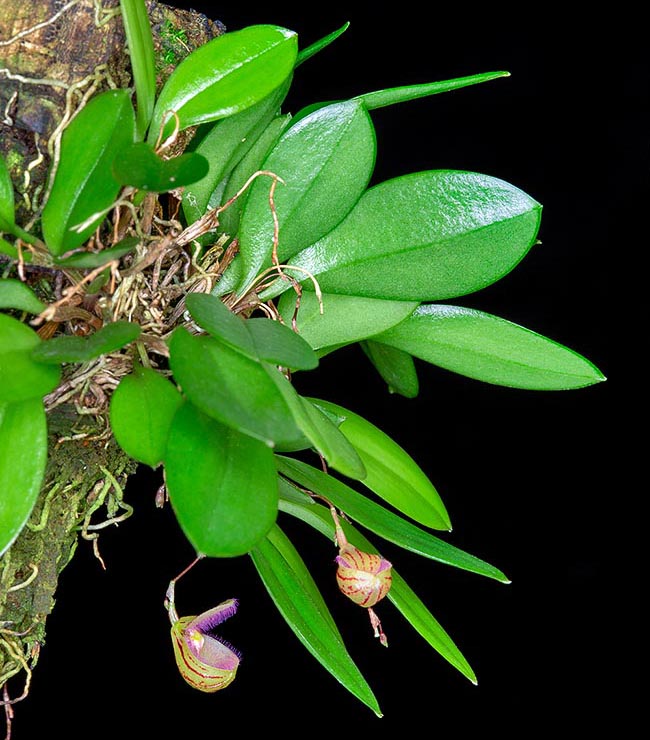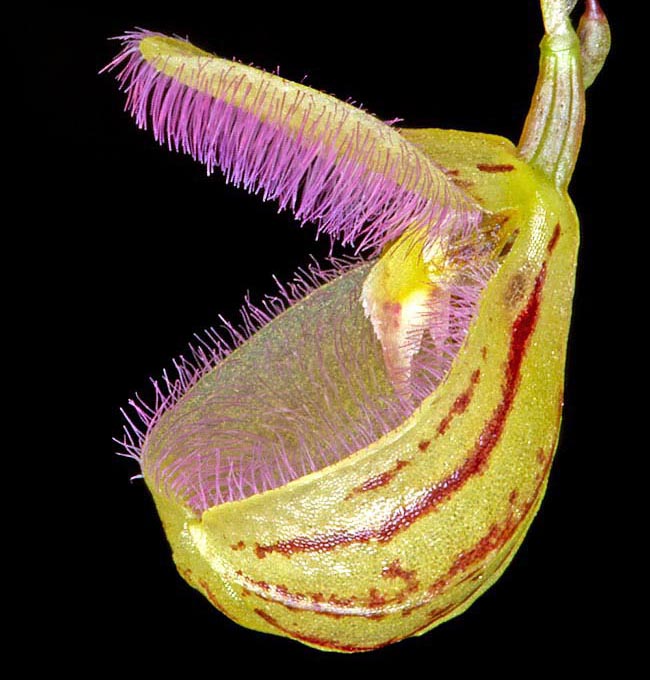Family : Orchidaceae

Text © Pietro Puccio

English translation by Mario Beltramini

Stelis cypripeodiodes is a cespitose epiphyte species native to to Ecuador forests between 350-1100 m of altitude © Giuseppe Mazza
The species is native to Ecuador where it grows on the trees of the humid forests between 350 and 1100 m of altitude.
The name of the genus is the Greek substantive “στηλίς” (stelis), utilized in ancient times to indicate the mistletoe (Viscum album L., 1753) that grows analogously on the trees; the specific name is that of the genus Cypripedium with the Greek suffix “-οειδής” (-oeidés), from “εἶδος“ (êidos) = shape, look, hence resembling, with reference to the flowers.
The Stelis cypripedioides (Luer) Pridgeon & M.W.Chase (2001) is a cespitose epiphyte species with creeping rhizome and unifoliate stems, 1-1,5 cm long, wrapped by tubular sheaths.
Elliptic leaves with acute apex, coriaceous, 3-6 cm long and 1,5-1,7 cm broad.
Filiform racemose inflorescences longer than the leaves, usually drooping, with zigzagging rachis and cream white flowers with purple maculae, of 5-7 mm of diameter, with the look reminding the Cypripedium, opening in succession for a long period; filiform pedicel and ovary just 6-7 mm long.
Oblong-ovate dorsal sepal with obtuse or acute apex, 6-8 mm long and 3-4 mm broad, obovate lateral sepals with obtuse apex, 7-9 mm long and 5-6 mm broad, united per all their length to form a sort of sac, glabrous outside and thickly covered by long white to purple hair internally.

Mini orchid with multicoloured and unusual hairy 5-7 mm flowers recalling the Cypripedium © Giuseppe Mazza
Obovate-rhomboid petals with acute apex, about 2 mm long and 1 mm broad, cordate unguiculate labellum (with narrowed base resembling a stem), with acute apex, about 3 mm long and 2 mm broad, and 3-4 mm long column.
It reproduces by seed, in vitro, and by division, with each section provided of at least 4-5 stems.
Mini orchid with flowers unusual for the genus, of easy cultivation, floriferous, requires a slightly shaded position, intermediate temperatures, with lowest winter values not under the 14 °C, high humidity, 70-80 %, and air in slight continuous movement.
It can be mounted on pieces of bark or rafts of various type with sphagnum at the base or cultivated in small pots, even suspended, seen the length, much bigger than that of the leaves, that may be reached by the inflorescences, with draining compost that may be formed by fragments of medium sliced bark or perlite and sphagnum.
Frequent watering, without ever allowing the substratum to dry up completely, but avoiding the stagnations, utilizing rainwater, de-mineralized or by reverse osmosis.
The species is inscribed in the appendix II of the CITES (species whose trade is internationally ruled).
Synonyms: Pleurothallis cypripedioides Luer (1975); Specklinia cypripedioides (Luer) Luer (2004); Effusiella cypripedioides (Luer) Luer (2007).
